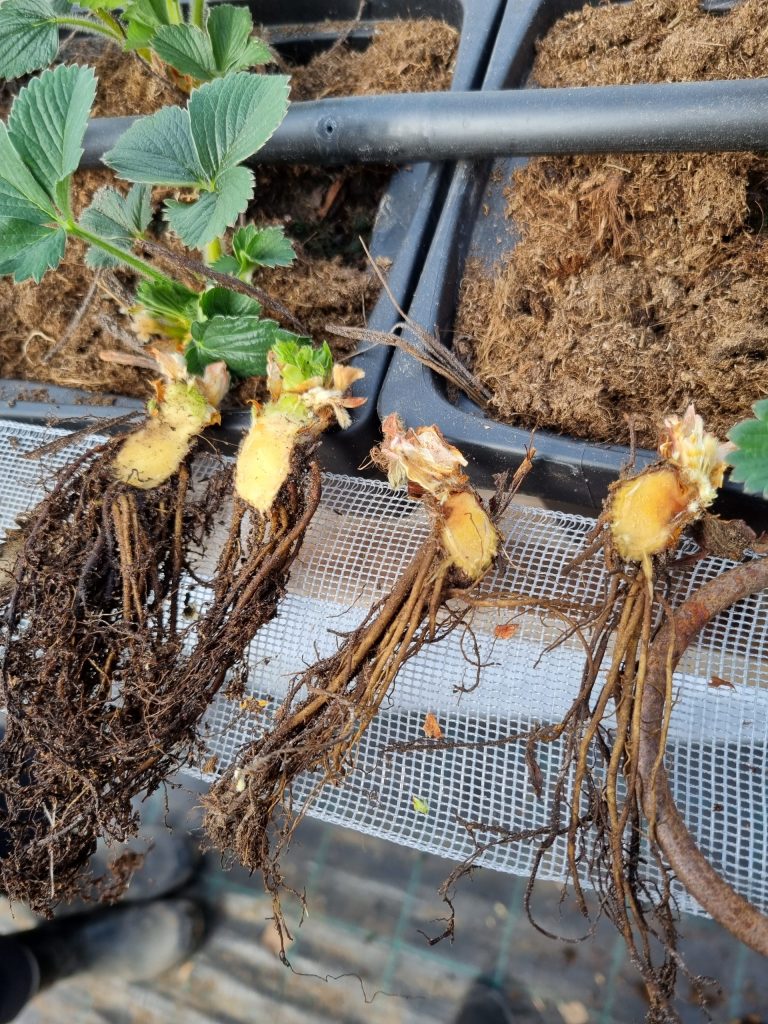This is a group of plant diseases that often affect for example strawberry plants and rhododendrons. However, specific types of Phytophthora can pose a danger to other crops as well. Phytophthora Cinnamomi for example can cause root rot in young plants. Most types of this disease cause plant illness like rot of various plant parts (varying from roots to stem, or even bulbs). Some specific types of Phytophthora can also specifically cause leaf burn or damage to fruits. Let’s see how to prevent Phytophthora.
Damage caused by Phytophthora is irreversible. It usually leads to the disposal of the affected plants or entire sections of crops within your cultivation site. That’s why it’s important to be aware of ways to deal with this issue.
How to detect Phytophthora
This plant disease can be challenging to detect, because of its quick progression. Phytophthora can quickly weaken your plants, making them more susceptible to other infections.
The quick pace at which it weakens your plants makes it especially important to quickly identify symptoms and act swiftly before severe damage is caused.
Symptoms of Phytophthora
Keep an eye out for the following symptoms to identify infected plants as these are signs of nutrient deficiencies and water stress that can be caused by damaged roots:
- Yellow foliage (discolouration),
- Leaf rot,
- Dotting of leaves or stems,
- Malformation,
- Stunted plant growth,
- Wilting or even necrosis.
Since weakened plants are more prone to also catching other infections, the symptoms might not always be easy to understand. You can also cut the stem of a possibly infected plant with a sharp knife. If it looks like the strawberry roots and stem in the picture below, your plant may be affected by Phytophthora. If you’re unsure of what is affecting your plants, you can request a DNA analysis at a nearby lab to identify the organism causing the issue.

Tips to prevent Phytophthora
Chemical treatment can be a last resort to try to control the disease at your cultivation site. However, it’s much less effective compared to taking the right preventative measures. Since it can cause plant loss on a large scale, an infection can become quite costly. For these reasons, it’s important to properly integrate the following preventative measures and to frequently check your plants.
Irrigation management
Irrigation management plays a big role in preventing water mould plant diseases like phytophthora. It’s highly important to adjust the frequency and amount of irrigation to your plants’ needs and to also adjust it based on environmental changes. For example, when growing strawberries in tunnels the air temperature and humidity can fluctuate depending on the weather. When the weather is cloudy and cold, the irrigation strategy needs to be different compared to when the weather is warm and there’s high solar radiation.
Read this related article if you want to know more about managing your irrigation strategy for soft fruits grown in tunnels.
Irrigation water also needs to be stored and handled with good practice to avoid any type of contamination. In the case of water storage in open ponds, it’s important to line them with special a type of pond liners/films that prevent contamination with open soil.
Substrate quality and management
This can also be of influence in the prevention of Phytophthora. Using substrate that fully supports the needs of your crop and your growing methods is important to prevent plant diseases. By offering an ideal growing environment to your plants, you help them maintain good health, making them more resilient to infections. By closely managing the pH and EC levels during cultivation (read this related article to learn more), you avoid them from rising too far. High pH and EC values can increase infection by phytophthora.
The moisture level is also something to closely manage. Of course, this is strongly related to your irrigation management, but it is also relevant when selecting your substrate. Some types of substrate have a higher water holding capacity than other types, requiring different growing methods during cultivation. When the substrate remains too wet over time, the plants will be more susceptible to phytophthora as well.
Inspection of new plant material
Closely inspecting new plant material is important to quickly identify possibly contaminated plants and quarantining them is always good practice. Make sure to use clean plant material from reliable suppliers. This helps prevent the spread of any type of plant disease or pathogen. The same goes for keeping your growing site tidy and clean and frequently disinfecting tools and equipment.
Talk to your distributor if you would like to know more about this plant disease.

